The APAC Commercial Glazing System Market is estimated to be valued at USD 19.4 billion in 2025 and is projected to reach USD 101.5 billion by 2035, registering a compound annual growth rate (CAGR) of 18.0% over the forecast period.
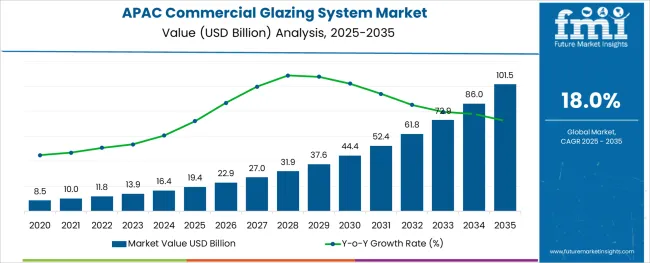
The APAC commercial glazing system market is witnessing substantial growth, driven by rapid urbanization, the expansion of smart infrastructure, and increased adoption of energy efficient building technologies. Strong construction activity across commercial sectors such as office spaces, healthcare, hospitality, and retail is creating sustained demand for high-performance glazing solutions.
Government-backed initiatives aimed at achieving green building certification, along with regulatory mandates focusing on thermal insulation and daylight optimization, are catalyzing the shift toward advanced glazing systems. Technological advancements in coatings, lamination, and smart glass integration have enabled superior thermal performance, noise control, and UV protection, which are becoming key differentiators in commercial building envelopes.
Furthermore, a growing emphasis on aesthetics and brand identity in corporate architecture is pushing adoption of customizable glazing formats. With rising energy costs and environmental compliance pressures, stakeholders across the value chain are aligning toward smart, durable, and sustainable commercial glazing solutions, reinforcing a robust growth trajectory across the region.
The market is segmented by Product Type, Glazing Type, Material, End Use, Technology, and Glass Coating and region. By Product Type, the market is divided into Windows, Doors, Curtain Walls, Skylights, Storefronts, and Sloped Glazing Systems. In terms of Glazing Type, the market is classified into Single Glazing, Double Glazing, Triple Glazing, and Smart Glazing. Based on Material, the market is segmented into Glass, Aluminum, Steel, Vinyl, and Composite. By End Use, the market is divided into Office Buildings, Retail Stores, Hotels, Healthcare Facilities, Educational Institutions, Industrial Buildings, and Other End Uses. By Technology, the market is segmented into Passive Glazing and Active Glazing. By Glass Coating, the market is segmented into Low-e Coatings, Reflective Coatings, Self-Cleaning Coatings, and Others. Regionally, the market is classified into North America, Latin America, Western Europe, Eastern Europe, Balkan & Baltic Countries, Russia & Belarus, Central Asia, East Asia, South Asia & Pacific, and the Middle East & Africa.
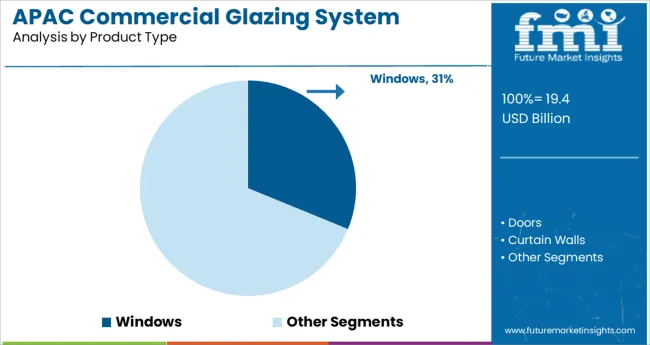
It is identified that the windows segment is projected to contribute 31.20% of total revenue by 2025 within the product type category, making it the leading sub-segment. This dominance is attributed to the increasing demand for energy efficiency, natural light optimization, and exterior aesthetics in commercial buildings. Glazed windows play a critical role in achieving thermal insulation and daylighting goals while supporting modern architectural designs.
In urban business districts, the preference for expansive glass facades and curtain wall systems has further elevated the use of glazed window installations. Additionally, regulatory norms mandating daylight access and ventilation in commercial spaces have encouraged widespread integration.
Ongoing innovations in solar control coatings and double-glazed assemblies have contributed to both environmental performance and occupant comfort, securing the window segment’s leadership within the product landscape.
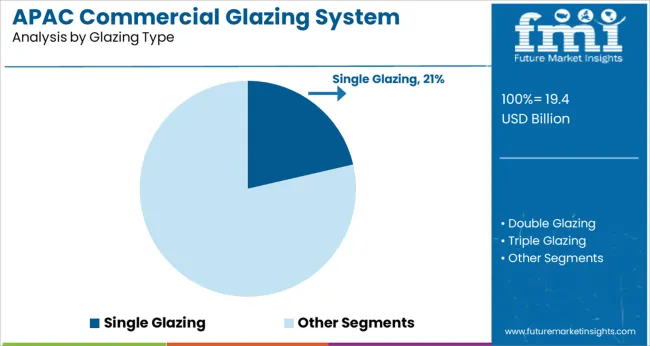
The single glazing segment is expected to account for 21.40% of total revenue by 2025 within the glazing type category. This share is driven by its continued application in cost-sensitive commercial projects and regions with moderate climate requirements.
Its advantages include lower material cost, ease of installation, and design flexibility, which have kept it in active circulation across developing urban areas. Furthermore, in low-rise commercial constructions and temporary infrastructure setups, single glazing is frequently selected for its functionality and affordability.
The segment’s contribution reflects its suitability for basic structural needs in a market where commercial diversification and tiered infrastructure investments continue to expand.
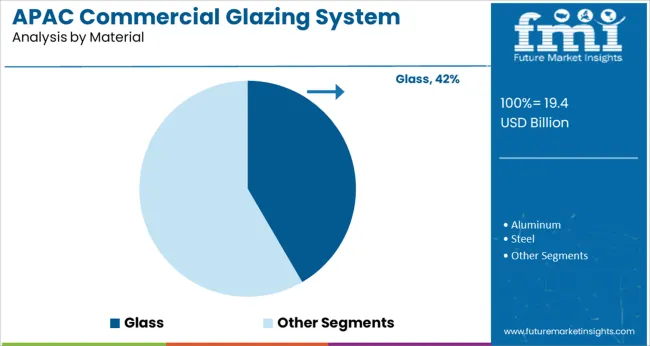
Glass is projected to hold 41.60% of total revenue within the material category, affirming its dominant role in the APAC commercial glazing system market. The widespread adoption of glass is driven by its versatility, performance, and alignment with modern design aesthetics. As commercial developers prioritize daylight harvesting, energy savings, and transparent façades, glass remains the material of choice.
The development of high-performance variants such as low-E, laminated, and reflective glass has allowed for multifunctional building envelopes that address thermal comfort, safety, and visual appeal simultaneously. Additionally, glass offers strong compatibility with emerging smart technologies, including dynamic tinting and solar control features.
Regulatory encouragement of green architecture and increasing occupant well-being considerations have further propelled glass usage. The material’s balance of structural integrity, customizability, and visual sophistication has solidified its leading position in the commercial glazing ecosystem.
Research shows that health, comfort and outputof employees in office are improved by a well-ventilated environment and access to natural light. These benefits are usually provided by strategically-placed windows.However, windows also invite unwanted heat loss/gain and condensation.
Therefore, the concept of smart windows has evolved in recent years and has played a major role in reducing the cost of developing and maintaining commercial buildings.This exciting, cutting-edge window technology allows consumers to block either all light or just some by simply turning a knob or pressing a button.
This type of light control could potentially save billions of dollars on heating, cooling and lighting costs. These high performance windows reduce energy consumption, minimise pollution sources, offer lower heat loss,and leak less air compared to traditional windows. Sometimes they also offer fire resistance which is an additional benefit.
A typical window glazing system comprises of structural frames, sealants, glass panes and spacers.Factors like visuals(privacy, viewand glare), sun control, ultraviolet control, and lighting during the day can be controlled to some extent by optimally designing and implementing the glazing system of a commercial building.
A glazing system is typically designed based on the building requirements, and is customised to suitdifferent purposes.Glazing systems are differentiated on the basis of use of structural silicon as a support. The commercial glazing market can also be segmented on the basis of technology into dynamic glazing system, multifunctional advanced glazing system and next generation thermally-insulated windows.
All major players in the commercial glazing system market offer a wide variety of structural designs to cater to customer requirements. The market can also be segmented on the basis of product into commercial windows, curtain walling, ground floor treatment and roof glazing.
The global commercial glazing market is highly dependent on construction sector, the developing markets of APAC such as China and India are estimated to be the key demand generator. Emerging markets of the Middle East are also expected to surface as major consumers of glazing systems over the next five year.
Automotive glazing is also an upcoming industry in the glazing system market. See-through body panels or rear windows, and transparent sunroofs are new trends in automobile manufacturing.
The commercial windowssegment presently dominates the UK marketand is anticipated to be the fastest growing segment of commercial glazing systems market by 2024 in APAC. The commercial window segment is estimated to growat a CAGR of 13-15% by 2024.
A shift towards urbanisation is spurring the growth of the curtain walling market especially in China. The curtain walling market in China is expected to grow at a CAGR of 10-12% through 2024.
Major players in the commercial glazing system market are Saint-Gobain,Solar Innovations, Bayer, DuPont, A.C. Yule and Sons Ltd., and Alcoa.Players are now seen investing more time in tapping into the retrofitting market rather than construction. Retrofitting refers to making an older building more efficient with regard to energy consumption and other credentials.
Due to diminishing energy resources, governmentregulations and environment consciousness, the demand for green buildings is increasing. Builders are now understanding the potential savings from retrofit investments.
Due to stringent government regulations for energy consumption, the expandingconstruction and service sector, the retrofitting trend, and the increasing interest in see through automobiles, the commercial glazing systems market is expected to havemuchuntapped potential, especially in APAC.
The research report presents a comprehensive assessment of market and contains thoughtful insights, facts, historical data, and statistically supported and industry-validated market data.It also contains projections using a suitable set of assumptions and methodologies.The research report provides analysis and information according to categories such as market segments, geographies, types, technology and applications.
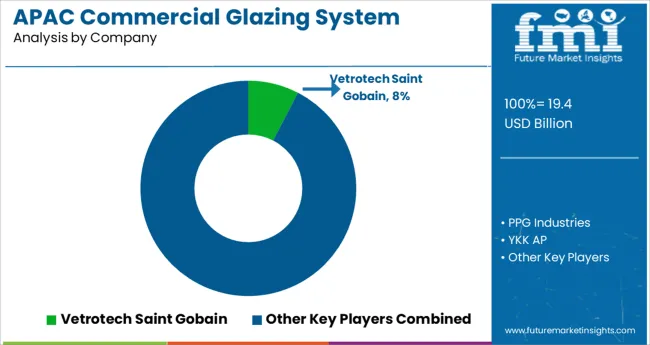
The report is a compilation of first-hand information, qualitative and quantitative assessment by industry analysts, inputs from industry experts and industry participants across the value chain.
The report provides in-depth analysis of parent market trends, macroeconomic indicators and governing factors, along with market attractiveness within the segments. The report also maps the qualitative impact of various market factors on market segments and various geographies.
The global apac commercial glazing system market is estimated to be valued at USD 19.4 billion in 2025.
It is projected to reach USD 101.5 billion by 2035.
The market is expected to grow at a 18.0% CAGR between 2025 and 2035.
The key product types are windows, doors, curtain walls, skylights, storefronts and sloped glazing systems.
single glazing segment is expected to dominate with a 21.4% industry share in 2025.






Full Research Suite comprises of:
Market outlook & trends analysis
Interviews & case studies
Strategic recommendations
Vendor profiles & capabilities analysis
5-year forecasts
8 regions and 60+ country-level data splits
Market segment data splits
12 months of continuous data updates
DELIVERED AS:
PDF EXCEL ONLINE
APAC Wiper Blade Industry Size and Share Forecast Outlook 2025 to 2035
APAC Fluoroelastomer Market Size and Share Forecast Outlook 2025 to 2035
APAC Solar Micro Inverters Market Analysis – Share, Size, and Forecast 2025 to 2035
APAC Automotive Telematics Market Growth - Trends & Forecast 2025 to 2035
APAC Biocomposites Market Growth - Trends & Forecast 2025 to 2035
APAC Savory Ingredients Market Analysis – Trends & Forecast 2016-2026
APAC Waste Heat Recovery Systems Market Size and Share Forecast Outlook 2025 to 2035
Capacitor Film Slitter Market Size and Share Forecast Outlook 2025 to 2035
Capacitance Meter Market Size and Share Forecast Outlook 2025 to 2035
Capacitive Tactile Sensor Market Size and Share Forecast Outlook 2025 to 2035
Capacitive Position Sensors Market Size and Share Forecast Outlook 2025 to 2035
Capacitive Sensor Market Analysis - Size, Share, and Forecast 2025 to 2035
Capacitive Proximity Sensor Market Trends - Growth & Forecast 2025 to 2035
Capacitive Touchscreen Market Insights – Growth & Forecast through 2034
Capacitor Kits Market
Fuel Capacitance Test Equipment Market Size and Share Forecast Outlook 2025 to 2035
Ultracapacitors Market Size and Share Forecast Outlook 2025 to 2035
Film Capacitors Market Analysis & Forecast by Material, Application, End Use, and Region Through 2035
Supercapacitors Market Report - Trends & Industry Outlook through 2034
Small Capacity Electrolyzer Market Size and Share Forecast Outlook 2025 to 2035

Thank you!
You will receive an email from our Business Development Manager. Please be sure to check your SPAM/JUNK folder too.
Chat With
MaRIA